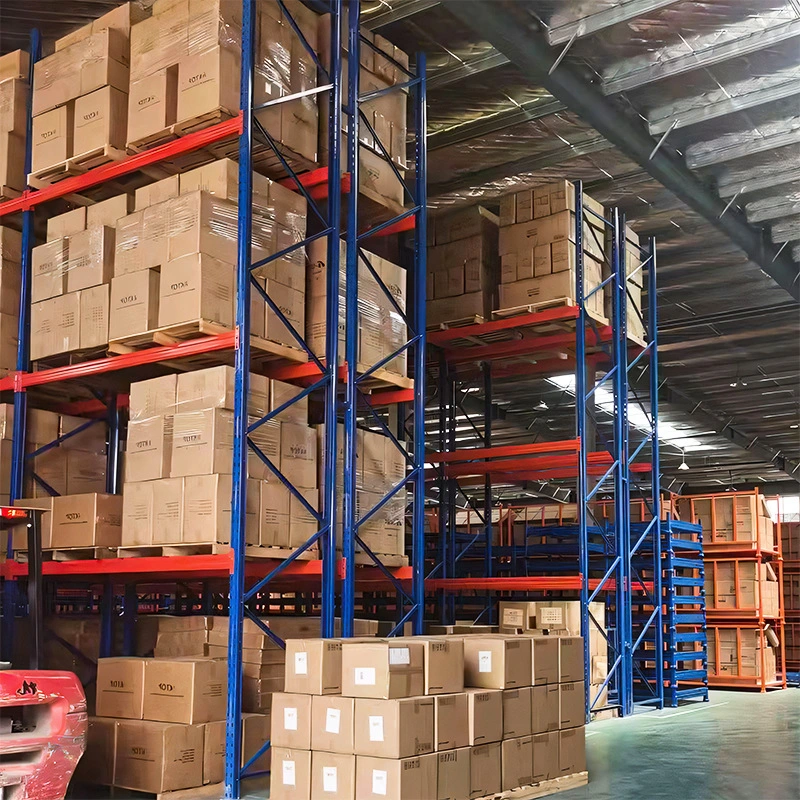Heavy Duty Racking Manufacturers Wholesale Storage Warehouse Large Storage Garage Shelving High Level Beam Type Storage Racking
Shelf is a steel or reinforced concrete structure of the building or structure, shelves within the standard size of the cargo space, alley stacking cranes through the shelves between the aisle, to complete the storage and retrieval of goods. Management using computer and bar code technology.
Industrial production areas.
1. Machinery manufacturing: one of the widely used automated three-dimensional library. Such as Trinity Heavy Industries, etc.
2. Electronics Manufacturing: Lenovo and other electronic fields in 2000 after the start of the automated three-dimensional library system.
3. Tobacco manufacturing: China's automated three-dimensional library of the most common industry. And a large number of imported equipment.
Logistics.
1. Airport Cargo: An early adopter of automated three-dimensional warehouses. All major airports have adopted the three-dimensional warehouse system for baggage handling.
2. Subway: With the vigorous rise of China's subway construction, automated three-dimensional warehouse application of a large area.
Product Parameter
|
Dimensional Warehouse |
|
|
Number of layers |
10-20 |
|
Weight |
4-8T |
|
Height |
4-8m |
|
Layer spacing |
450mm |
|
ootprint size (length*width) |
4700*4400mm |
|
Lift Truck |
|
|
Maximum lifting weight |
5t |
|
Maximum lifting speed |
200mm/s |
|
Maximum push-pull tray speed |
200mm/s |
Product advantage
Sheet metal standing storage operation process
The main body of a sheet metal standing warehouse consists of shelves, alley stacking cranes, inlet (outlet) tables and automatic inlet (outlet) and operation control systems. A rack is a steel or reinforced concrete building or structure with a standard size cargo space inside. The aisle stacker crane travels through the aisles between the racks to complete the storage and retrieval work; it is controlled and managed by the WCS system.
● Inventory Process: The Sheet Metal LIBOR system responds to the request for inventory, pops up the inventory dialog box, and the user fills in the name and quantity of the goods to be inventoried;
● The system queries the order quantity. If the order quantity is greater than the inventory quantity of the goods, an alarm will be issued. Otherwise, the sheet metal warehouse system sends a warehouse operation task list to the warehouse computer, prints the warehouse document, and the warehouse computer controls the barcode system to scan the goods. After scanning, the warehouse computer will determine whether the scanned goods and the task are consistent. If they are consistent, storage sorting and transportation will be carried out. If they are inconsistent, an alarm signal will be issued.
● Packaging and boxing: Before small goods or parts enter the sheet metal warehouse, they are generally required to be packaged and boxed to meet storage requirements and make full use of storage space.
● Barcode Input: The barcode representing the goods in a sheet metal standing warehouse generally contains four types of information: pallet number, article number, lot number, and quantity. The barcode is read in by the scanner, interpreted by the decoder, and then transferred to the computer via the serial port interface.
● Outbound process: The process of goods out of the sheet metal warehouse is as follows: the system responds to the outbound request, a dialog box pops up, and the user fills in the name and quantity of the goods out of the warehouse.
Contact: Heidi
Tel: +86 183 2103 6277
E-mail: Heidi@cian-sung.com
WhatsApp:+86 183 2103 6277
Add:
【International Marketing Department】
11A Yindong BLG. No.58 Xinjinqiao RD. Pudong Shanghai, China
【Suzhou Factory】
No.111, Nanyuan Road, South District, Zhangjiagang Economic and Technological Development Zone, Jiangsu Province, China
【Xuzhou Factory】
No. 19 Wujiang Road, Taishang Industrial Zone, Yitang Town, Pizhou City, Jiangsu Province, China











